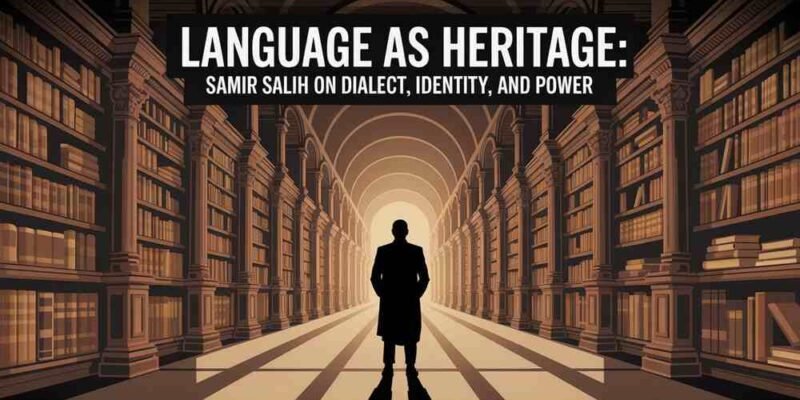Introduction
Language is more than a communication tool; it is a vessel of culture, memory, and identity. For renowned cultural theorist Samir Salih, language, particularly dialects, is critical in preserving heritage and asserting collective identity. His work explores how dialects are not merely linguistic variants but powerful social belonging and political expression markers. In this article, we examine Samir Salih’s perspective on dialects, their role in shaping identity, and how language serves as both a tool and a battleground for power.
Understanding Language as Cultural Heritage
Language is intrinsic to heritage. It encodes traditions, rituals, and social norms passed down through generations. For Samir Salih, heritage is not only about monuments or artifacts but also about intangible cultural expressions, especially language.
The Threat to Dialects
Salih warns that globalization, urbanization, and linguistic homogenization threaten dialects. As dominant languages expand through education, media, and policy, minority dialects face marginalization. According to Salih, this erasure is not accidental but often a consequence of historical power dynamics and state centralization.
The Emotional Weight of Words
Salih often emphasizes the emotional resonance of native speech. A dialect, he asserts, carries with it stories of ancestors, idioms rooted in local wisdom, and a rhythm reflective of a community’s history. In Salih’s view, losing an intimate part of one’s cultural DNA is to lose a dialect.
Samir Salih on Identity and Linguistic Belonging
Language as Identity Marker
Samir Salih positions language as a cornerstone of identity. While national or official languages may provide unifying platforms, dialects serve as identifiers of regional, ethnic, or class-based identities. Salih’s ethnographic research showcases how people emotionally attach themselves to their dialects, seeing them as integral to their identity.
“To speak a dialect is to say: I belong, I remember, I resist.” — Samir Salih.
Dialect as Resistance
In many of Salih’s case studies, dialects have been used as forms of cultural resistance. Marginalized groups often cling to their local speech as a defiant act against cultural erasure. Salih parallels this phenomenon, and post-colonial societies reclaim native languages instead of imposed colonial tongues.
The Politics of Language: Who Gets to Speak and Be Heard
Standardization and Power Structures
According to Salih, the institutionalization of “standard” language often reflects the values and perspectives of dominant groups. Education systems, governments, and mass media prioritize these languages, reinforcing social hierarchies. Salih critiques how this marginalizes speakers of dialects, branding them as “uneducated” or “backward.”
Linguistic Hierarchies
Salih’s work often highlights the existence of linguistic hierarchies that mirror socio-economic divides. Those who speak standard or elite languages tend to have better access to opportunities, while dialect speakers may face discrimination or invisibility.
Language Policy and Cultural Suppression
In several of his publications, Salih explores how state-led language policies can function as tools of cultural suppression. He documents how the banning or discouraging of dialect use in schools, workplaces, and public life leads to generational discontinuity and cultural fragmentation.
Dialect and Oral Histories: Salih’s Fieldwork
Preserving Endangered Dialects
Samir Salih has been deeply involved in fieldwork to document and preserve endangered dialects. His methodology involves recording oral histories, folk songs, and everyday conversations. These recordings form part of a growing digital archive accessible to researchers and cultural institutions.
Ethnographic Methodologies
Salih employs participatory ethnography, often living among communities to fully understand their linguistic landscape. His immersive approach allows him to trace lexical differences and the cultural contexts in which language operates.
The Role of Women in Language Preservation
In several case studies, Salih observes that women, particularly elders, are the primary custodians of dialects. From lullabies to storytelling, their role in intergenerational transmission is vital—Salih advocates for including women’s voices in linguistic preservation efforts, noting their often-overlooked contributions.
Technology and the Revival of Dialects
Digital Archives and AI Tools
Salih is a proponent of using technology for cultural preservation. He collaborates with linguists and technologists to build open-access dialect archives. These include phonetic transcriptions, audio recordings, and contextual explanations of regional idioms.
Community-Led Apps
Inspired by Salih’s framework, several community-led initiatives have developed mobile apps that teach dialects to younger generations. These apps include quizzes, storytelling formats, and real-time speech recognition to foster engagement and learning.
Risks of Digital Misrepresentation
Despite these advancements, Salih cautions against decontextualizing dialects in tech platforms. He stresses the importance of community involvement to ensure dialects are represented respectfully and accurately.
Language and Memory: A Living Archive
Linguistic Memory and Generational Links
For Salih, language is a living archive that bridges generations. He notes that dialects contain embedded memories—terms for tools, rituals, and ecological knowledge that may have disappeared in modern life. Preserving these expressions helps maintain a cultural continuum.
Diaspora and Linguistic Identity
Salih has also studied how diaspora communities use dialects to maintain a connection to their homeland. Whether spoken at family gatherings or embedded in ritual practices, dialects become symbolic anchors of origin and belonging in foreign cultural contexts.
Challenges to Preservation
Youth Disinterest
One of the key challenges Salih identifies is the declining interest among youth in learning dialects. Urban migration and the dominance of global media contribute to a sense that dialects are outdated or irrelevant.
Lack of Institutional Support
Salih criticizes the lack of government support for linguistic diversity. He calls for policy reforms that integrate dialect education into school curricula, fund research initiatives, and protect linguistic rights as part of broader cultural policies.
Samir Salih’s Recommendations for the Future
Policy Advocacy
Salih urges for comprehensive language policies that recognize dialects as cultural assets. He supports legislation that promotes multilingual education and protects linguistic minorities.
Community Empowerment
He emphasizes grassroots empowerment, urging communities to take ownership of their linguistic heritage. This includes training local youth in oral history methods and dialect documentation.
Academic and Cultural Collaboration
Salih advocates for interdisciplinary collaboration between linguists, anthropologists, technologists, and artists. He believes such alliances are essential to revitalizing dialects in dynamic, engaging ways.
Conclusion
Samir Salih’s work on dialects, identity, and power reminds us that language is not just a tool of expression—it is a repository of memory, a marker of belonging, and a site of resistance. In an increasingly homogenized world, preserving dialects becomes an act of cultural survival. Through his scholarship, fieldwork, and advocacy, Salih calls on us to honor the voices of the past while empowering future speakers.
Do Read: Duke Kenneth Fluent – Biography, Career, and Personal Life













